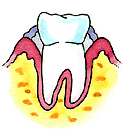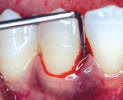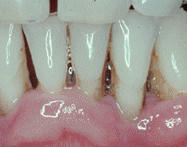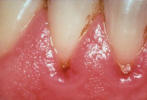
Symptoms of Gum Disease
The biggest danger of periodontal disease is that most of the patients are unaware of their problem, at least during the first stages of periodontal disease. The good news is that the condition is preventable, and at the first stages it can be treated easily and successfully without any permanent damage. If the condition is detected early, improved oral hygiene is usually enough to restore the health of the gums.
Gum disease symptoms – Symptoms of Gingivitis
 Gingivitis is the mildest type of periodontal disease. The dental plaque bacteria have infected the gingival tissues which get inflamed, but the bone around teeth is not yet affected.
Since there is no bone loss, if the gingivitis symptoms are recognized, the condition is still reversible with careful oral hygiene and non-surgical gum disease treatments such as tooth scaling and root planing.
Gingivitis is the mildest type of periodontal disease. The dental plaque bacteria have infected the gingival tissues which get inflamed, but the bone around teeth is not yet affected.
Since there is no bone loss, if the gingivitis symptoms are recognized, the condition is still reversible with careful oral hygiene and non-surgical gum disease treatments such as tooth scaling and root planing.
Common gingivitis symptoms include:
- Red, tender or swollen gums.
- Bleeding gums during brushing, flossing or eating hard foods. Gums that bleed constantly every time you brush or floss your teeth is almost always a symptom of gingivitis or periodontitis. However, some patients after some incidents of gum bleeding may start to avoid brushing close to the gums instead of visiting their dentist. This way, they are not only hiding the symptoms of gum disease but they also worsen their condition by not removing dental plaque properly.
- Bad breath or/and metallic taste in the mouth.
- Loss of attachment between teeth and gums (pocket creation) – healthy gums are attached firmly around teeth. Gum disease causes loss of connective tissue destroying the periodontal ligament that keeps the gums attached on teeth. The gums start to look separated from the teeth surface and pockets that harbor bacteria start to form between gums and teeth.
- Receding gums – gums that pull away from teeth and recede are common symptoms of gum disease. An indication of gums recession are teeth that appear longer than what they used to be.
- Sensitive teeth or pain on chewing.
It is important that everyone knows how gingivitis looks like, in order to seek treatment when any symptom of gum disease first appears.
Gum disease symptoms – Symptoms of Periodontitis
 Periodontal disease is in most cases a very slow progressing condition.
Many patients get used to the symptoms as their intensity progresses and get worried only when the symptoms of gum disease become extremely severe.
The following symptoms are a clear sign for the existence of advanced periodontal disease that requires immediate treatment. At this stage there is increasing loss of bone and gum tissue and there is a high risk of tooth loss.
Periodontal disease is in most cases a very slow progressing condition.
Many patients get used to the symptoms as their intensity progresses and get worried only when the symptoms of gum disease become extremely severe.
The following symptoms are a clear sign for the existence of advanced periodontal disease that requires immediate treatment. At this stage there is increasing loss of bone and gum tissue and there is a high risk of tooth loss.
Symptoms of advanced periodontal disease (periodontitis) include:
- Severely tender, swollen and painful gums.
- Persistent bad breath or bad taste in the mouth (even after bushing teeth).
- Severe gum recession – the tooth roots become exposed and visible.
- Deep periodontal pockets – in periodontitis, gums get detached from teeth and the periodontal pockets get deeper in the bone, sometimes reaching to the tips of the tooth roots.
- Pus formation - the infection of the gums may cause a periodontal abscess. Dead white blood cells that have been fighting the gum infection get trapped close to the tooth roots creating pus. Pus starts coming out from between teeth and gums.
- Spontaneously bleeding gums - blood in the mouth when waking up in the morning is a symptom of advanced periodontal disease.
- Increased space between the teeth – the gums that in a healthy mouth fill the space between teeth, recede leaving an empty space. As a result teeth look separated from each other.
- Increased teeth mobility – Due to the loss of connective and bone tissue around teeth roots, teeth become loose in their sockets. Teeth may also start to move or look like they have moved from their original position
- Change in the way teeth fit together when you bite – loss of bone and connective tissue around teeth roots can make a tooth ‘retreat’ into the jawbone increasing the distance between an upper and its opposite lower tooth. Teeth mobility may also cause malocclusion and jaw misalignment issues.
Early symptoms of gums disease
 Pain is usually not a symptom, which partly explains why periodontal disease may become advanced before the patient visits a dentist and why some patients do not seek treatment even after periodontitis is diagnosed.
Pain is usually not a symptom, which partly explains why periodontal disease may become advanced before the patient visits a dentist and why some patients do not seek treatment even after periodontitis is diagnosed.
Check your gums regularly for any of these first signs of gum disease:
- Change in the color of the gums – healthy gums have normally a pink or coral pink color. Gums inflammation caused by bacterial infection causes a change of gums color from pink to darker red. Reddish gums are usually the very first symptom of gum disease
- Gums that may bleed when you brush or floss without any sign of trauma – occasional gums bleeding is usually a sign of periodontal disease but not always, it can be also caused by trauma due to vigorous or incorrect tooth-brushing.
- Gums start to look more shiny and smooth.
- Teeth start to show symptoms of sensitivity – Gum recession may not be noticed because gums pull away very slowly day by day. Sensitive teeth can be a first sign of gum recession that exposes part of the tooth root.
In general, the severity of gum disease symptoms increases slowly over time, depending on the progress of the destruction of the connective and bone tissues supporting teeth in place. As the symptoms become more intense, so does the risk of tooth loss and the difficulty of the periodontal disease treatment.
Many patients visit their dentist with serious periodontal disease because they are not aware of what does gingivitis looks like in its early stages. If you notice any of the warning symptoms of gum disease, you should visit your dentist or a periodontist for a complete periodontal examination.

